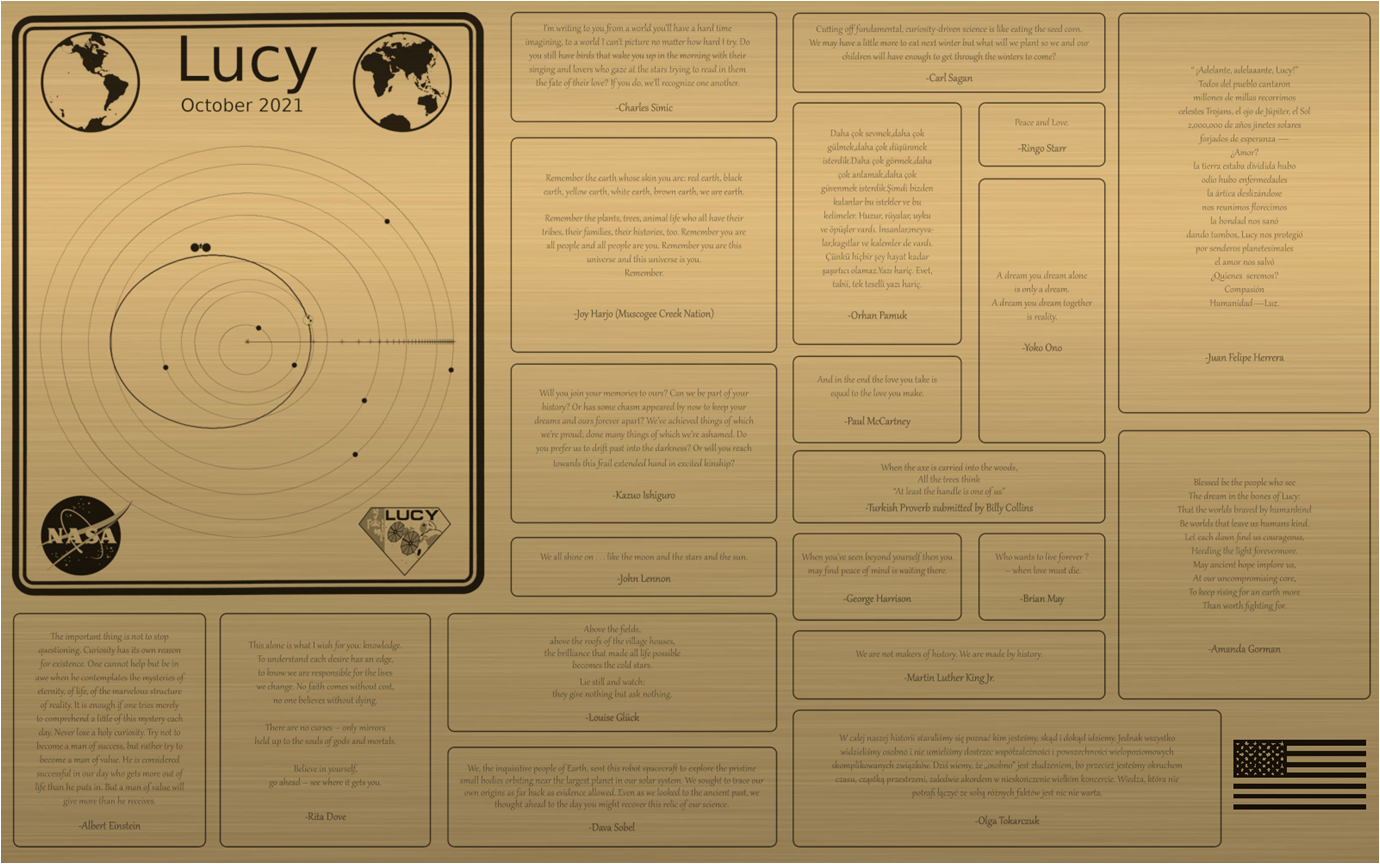NASA's Lucy asteroid probe has a time capsule plaque with messages to future humans
NASA's Lucy asteroid mission launching this weekend will carry on a deep-space tradition of bringing a commemorative plaque along for the cosmic ride.
Set to launch no earlier than Saturday (Oct. 16), the Lucy spacecraft is expected to swing by at least eight asteroids during its lifetime and its plaque acts as a nod to space history with a twist. Instead of hailing aliens, as previous NASA messages aimed to do, the Lucy plaque will serve as a reminder of the value of space exploration to humanity's own descendants.
"This time capsule contains messages from prominent members of our society; individuals who have asked us to contemplate the state of the human condition as well as our place in the universe," NASA said in a statement. "These thoughtful leaders were asked to provide words of advice, words of wisdom, words of joy, and words of inspiration to those who may read this plaque in the distant future."
Related: Meet the 8 asteroids NASA's Lucy spacecraft will visit
Mission principal investigator Hal Levison told Space.com that the Lucy plaque is meant to be a deliberate nod to the Pioneer 10 and 11 spacecraft, and Voyager 1 and 2 spacecraft, which all carried plaques far out in the solar system after launches in the 1970s. (Voyager 1 and 2 continue to deliver science results from interstellar space, but may fall silent in a few years as power supplies diminish — the same fate that the Pioneers met.)
"I was in middle school when the Pioneers launched, and in high school when the Voyagers were launched, and I remember really feeling motivated and inspired by those plaques," Levison told Space.com.
To him, he added, the Pioneer and Voyager plaques reduced the separation between living on Earth and exploring the galaxy, especially as they had messages from humanity to any extraterrestrials who may come across them.
Breaking space news, the latest updates on rocket launches, skywatching events and more!
The Lucy plaque — which will stay inside the solar system — is made not for aliens, but for future humans. The mission team, Levison said, "could imagine some [future] astroarchaeologists flying around the solar system, picking up junk, trying to figure out what we were like."
Related: NASA's Lucy asteroid mission will explore mysteries of early solar system
The plaque includes words from a spectrum of individuals, including Nobel Laureates in literature and United States poet laureates. All four members of the famous 1960s band The Beatles, as well as associated artist Yoko Ono, are also included; the Lucy mission is indirectly named for their hit song, "Lucy in the Sky With Diamonds."
The official Lucy website has a list of the messages as well as an image of the plaque, and you can also hear from some of the message selectees in this NASA video.
A selection of the plaque quotes include:
- "When you've seen beyond yourself, then you may find peace of mind is waiting there." — George Harrison, The Beatles lead guitarist, who died in 2001.
- "Blessed be the people who see / The dream in the bones of Lucy: / That the worlds braved by humankind / Be worlds that leave us humans kind …" — excerpt from Amanda Gorman, Black poet, activist and National Youth Poet Laureate, who recently spoke at U.S. President Joe Biden's inauguration.
- "Remember the earth whose skin you are: red earth, black earth, yellow earth, white earth, brown earth, we are earth." — excerpt from Joy Harjo, member of the Muscogee Nation and United States poet laureate.
There will be plenty of time for future humans to catch up to Lucy. The mission will survey the Trojan asteroids that share Jupiter's orbit, which have never been seen up close. After Lucy's primary mission ends, the spacecraft is expected to remain in orbit between the Trojans and Earth for "at least hundreds of thousands, if not millions of years," NASA said.
Reporting contributed by Space.com senior writer Meghan Bartels. Follow Elizabeth Howell on Twitter @howellspace. Follow us on Twitter @Spacedotcom and on Facebook.

Elizabeth Howell (she/her), Ph.D., was a staff writer in the spaceflight channel between 2022 and 2024 specializing in Canadian space news. She was contributing writer for Space.com for 10 years from 2012 to 2024. Elizabeth's reporting includes multiple exclusives with the White House, leading world coverage about a lost-and-found space tomato on the International Space Station, witnessing five human spaceflight launches on two continents, flying parabolic, working inside a spacesuit, and participating in a simulated Mars mission. Her latest book, "Why Am I Taller?" (ECW Press, 2022) is co-written with astronaut Dave Williams.

